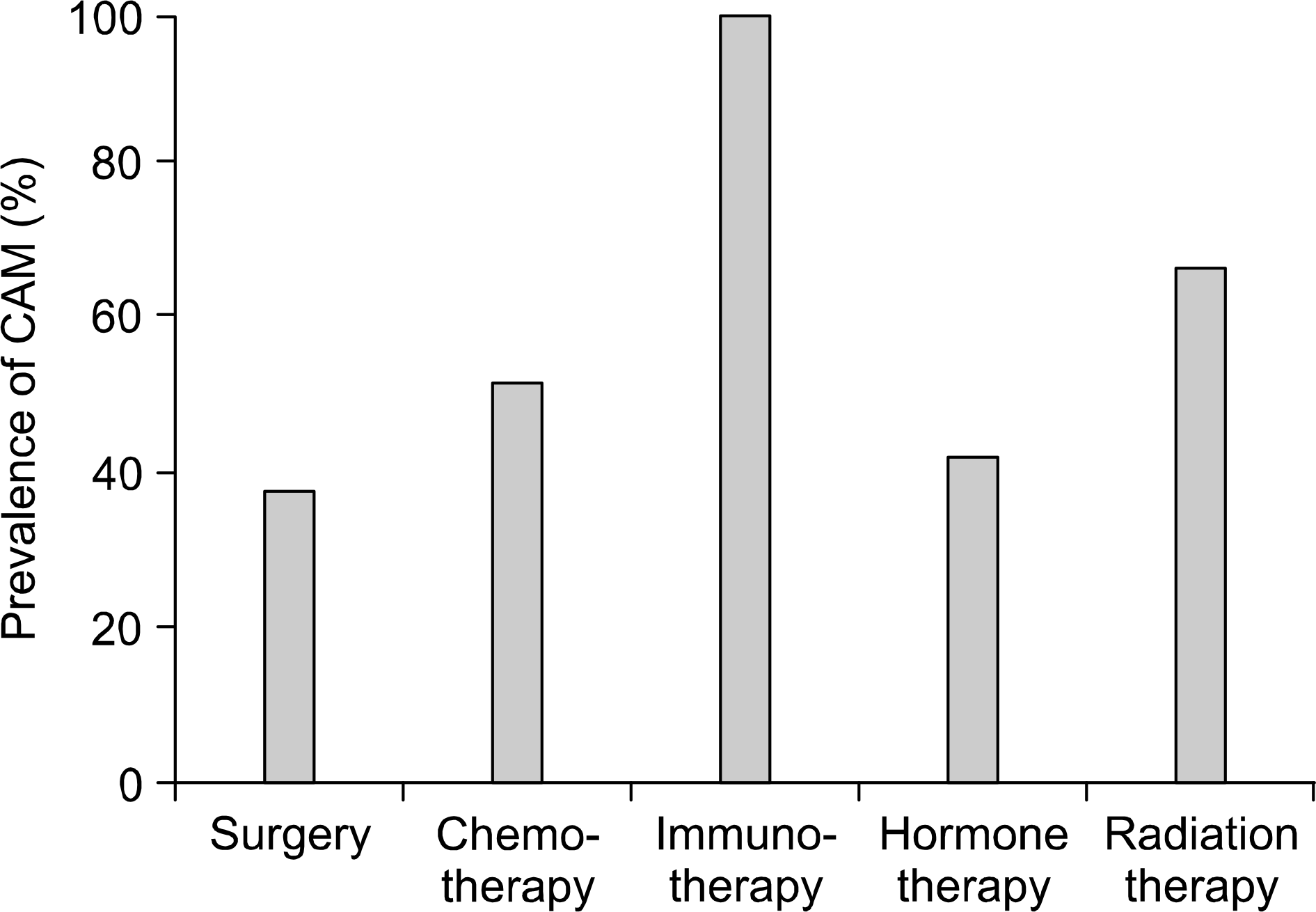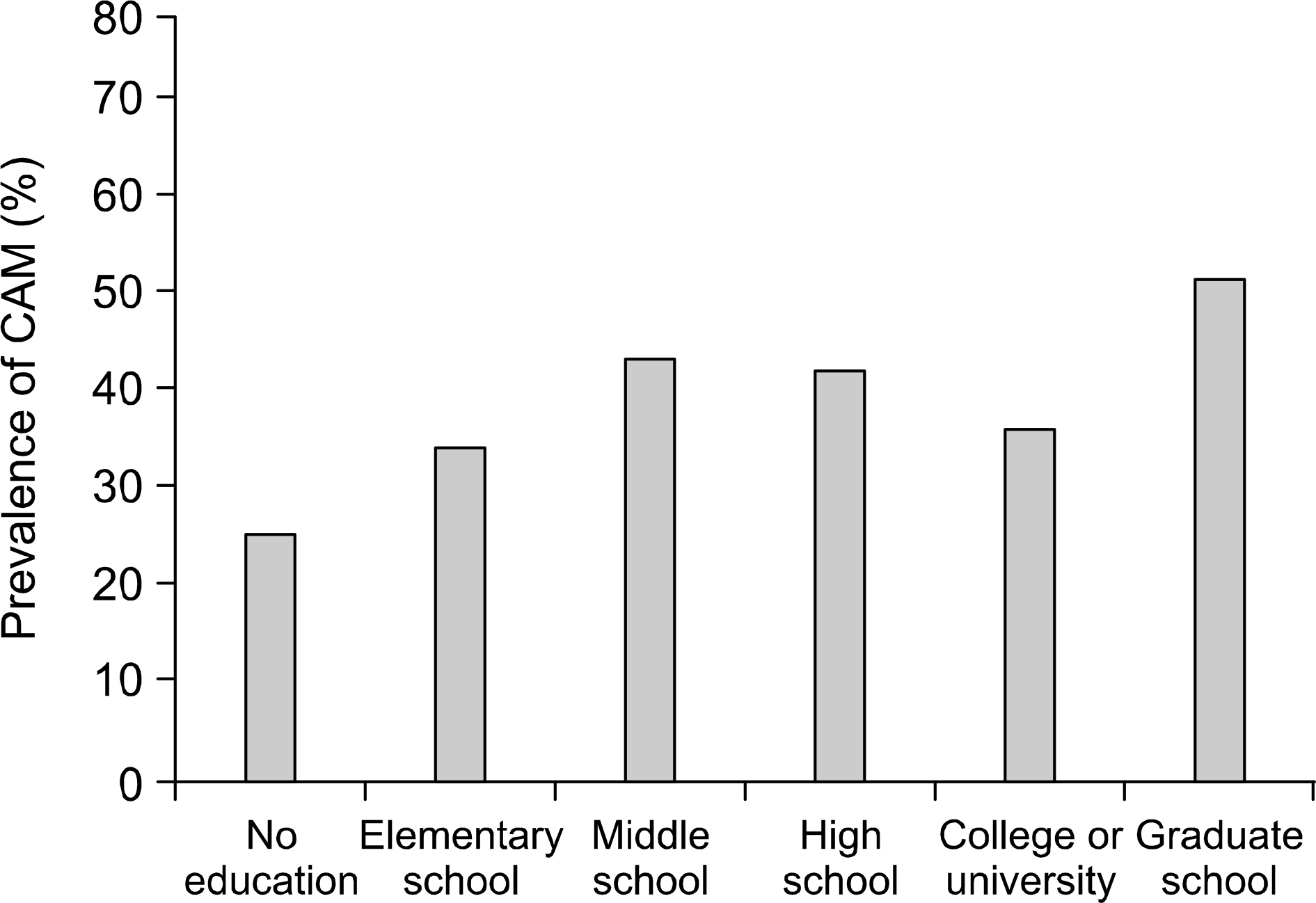Abstract
Purpose:
The use of complementary and alternative medicine (CAM) is very common among patients with a urological malignancy. We assessed the prevalence and patterns of use of complementary therapies among patients with bladder, prostate and renal cancers.
Materials and Methods:
Between May and July 2004, we conducted a survey to assess the use of CAM at 13 outpatient clinics in Korea. Seven hundred and eleven patients with bladder (269), prostate (300) or renal cancers (142) were selected to answer a self-administered questionnaire on CAM, which were then analyzed.
Results:
Among 711 patients with urological malignancies, 279 (39.2%) had been treated with at least one type of CAM, in addition to conventional Western treatment. The cancer patients treated with radiation therapy or immunotherapy were more likely to employ CAM than those using other therapies. Age, gender, cancer type, occupations, religions, level of education and disease status (stable or progressive) were not associated with the prevalence of CAM. 44.3% of CAM users wanted to discuss CAM techniques with their doctors, but only 24.8% received an explanation of there use.
Conclusions:
CAM is used by a large number of patients with urological malignancies, particularly in those undergoing radiation therapy or im- munotherapy. Urologists need to have an accurate knowledge and apprehension of CAM. The possible effects and side effects should be defined, with appropriate guidelines recommended for patients with a urological malinancy. (Korean J Urol 2006;47:620-624)
Go to : 
REFERENCES
1.Eisenberg DM., Kessler RC., Foster C., Norlock FE., Calkins DR., Delbanco TL. Unconventional medicine in the United States. Prevalence, costs, and patterns of use. N Engl J Med. 1993. 328:246–52.
2.Eisenberg DM., Davis RB., Ettner SL., Appel S., Wilkey S., Van Rompay M, et al. Trends in alternative medicine use in the United States, 1990-1997: results of a follow-up national survey. JAMA. 1998. 280:1569–75.
3.Wilkinson S., Gomella LG., Smith JA., Brawer MK., Dawson NA., Wajsman Z, et al. Attitudes and use of complementary medicine in men with prostate cancer. J Urol. 2002. 168:2505–9.

4.Lee SI., Khang YH., Lee MS., Kang W., Hong CD. Complementary and alternative medicine use in Korea: prevalence, pattern of use, and out-of-pocket expenditures. Korean J Prev Med. 1999. 32:546–55.
5.Kim MJ., Lee SD., Kim DR., Kong YH., Sohn WS., Ki SS, et al. Use of complementary and alternative medicine among Korean cancer patients. Korean J Intern Med. 2004. 19:250–6.

6.Ernst E., Cassileth BR. The prevalence of complementary/alternative medicine in cancer: a systematic review. Cancer. 1998. 83:777–82.
7.Khang YH., Lee MS., Koo HJ., Kang WC., Lim BM., Lee SI. Comparison of doctors' experience with and attitudes toward complementary and alternative medicine between western medicine and Korean traditional medicine in office-based settings. J Korean Acad Fam Med. 1999. 20:1106–17.
8.Boon H., Stewart M., Kennard MA., Gray R., Sawka C., Brown JB, et al. Use of complementary/alternative medicine by breast cancer survivors in Ontario: prevalence and perceptions. J Clin Oncol. 2000. 18:2515–21.

9.Astin JA. Why patients use alternative medicine: results of a national study. JAMA. 1998. 279:1548–53.

10.Ernst E., Willoughby M., Weihamyr T. The sick role of proponents and opponents of complementary medicine. Complement Ther Nurs Midwifery. 1996. 2:102–5.

11.Faw C., Ballentine R., Ballentine L., vanEys J. Unproved cancer remedies. A survey of use in pediatric outpatients. JAMA. 1977. 238:1536–8.

12.Arkko PJ., Arkko BL., Kari-Koskinen 0., Taskinen PJ. A survey of unproven cancer remedies and dieir users in an outpatient clinic for cancer therapy in Finland. Soc Sci Med. 1980. 14:511–4.
13.Downer SM., Cody MM., McCluskey P., Wilson PD., Amott SJ., Lister TA, et al. Pursuit and practice of complementary therapies by cancer patients receiving conventional treatment. BMJ. 1994. 309:86–9.

14.Yi JJ., Ohrr H., Yi SW. A study on die cost and proportion of complementary and alternative medicine in total healthcare cost among elderly in the last 6 mondis of life. Korean J Prev Med Public Health. 2004. 37:141–9.
15.Hyodo I., Eguchi K., Nishina T., Endo H., Tanimizu M., Mikami I, et al. Perceptions and attitudes of clinical oncologists on complementary and alternative medicine: a nationwide survey in Japan. Cancer. 2003. 97:2861–8.
16.Fair WR. Willet F. Whitore, Jr. Lecture: back to the future-the role of complementary medicine in urology. J Urol. 1999. 162:411–20.
Go to : 
 | Fig. 1.Prevalence of complementary and alternative medicine (CAM) according to treatment modality. |
 | Fig. 2.Prevalence of complementary and alternative medicine (CAM) according to the degree of education. |
Table 1.
Patient characteristics
Table 2.
Types of complementary and alternative medicine (CAM)




 PDF
PDF ePub
ePub Citation
Citation Print
Print


 XML Download
XML Download